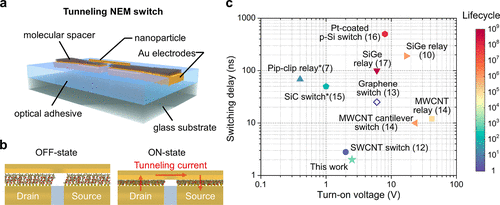
Jinchi Han, Zachary Nelson, Matthew R. Chua, Timothy M. Swager, Farnaz Niroui, Jeffrey H. Lang, and Vladimir Bulovic
https://pubs.acs.org/doi/10.1021/acs.nanolett.1c03214
Abstract:
The use of molecules as active components to build nanometer-scale devices inspires emerging device concepts that employ the intrinsic functionality of molecules to address longstanding challenges facing nanoelectronics. Using molecules as controllable-length nanosprings, here we report the design and operation of a nanoelectromechanical (NEM) switch which overcomes the typical challenges of high actuation voltages and slow switching speeds for previous NEM technologies. Our NEM switches are hierarchically assembled using a molecular spacer layer sandwiched between atomically smooth electrodes, which defines a nanometer-scale electrode gap and can be electrostatically compressed to repeatedly modulate the tunneling current. The molecular layer and the top electrode structure serve as two degrees of design freedom with which to independently tailor static and dynamic device characteristics, enabling simultaneous low turn-on voltages (sub‑3 V) and short switching delays (2 ns). This molecular platform with inherent nanoscale modularity provides a versatile strategy for engineering diverse high-performance and energy-efficient electromechanical devices.
